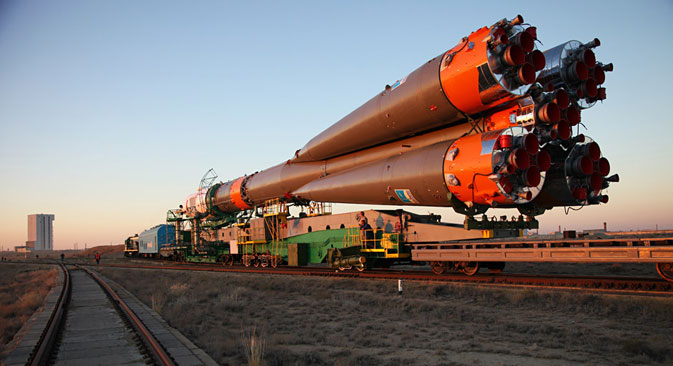
The launch of the next Russian rocket is planned for Sept. 26. Soyuz TMA-10M will carry the Expidition 37 crew to the ISS, including America's Michael Hopkins and Russia's Oleg Kotov and Sergei Ryazansky. Source: AFP / East News
Launch vehicles were once considered the Russian space industry’s main trump card. But in less than a decade, there have been more than a dozen accidents involving launch vehicles, most notably a Proton-M launch in July.
The failures of the launch vehicles are just the latest indication that the Russian space industry needs reform. The management of the space industry is far from efficient. In addition, the industry suffers from completely worn out equipment.
Meanwhile, skilled workers are getting older and low wages are not attracting young specialists into the sector. And that’s not all. The challenges facing the industry are so great that the highest levels of government are getting involved.
At the beginning of August Dmitry Rogozin, the deputy prime minister with responsibility for the space industry, announced: “There are so many problems in the astronautics industry that the government is simply not justified in affording the sector the opportunity to resolve them at its own discretion. The sector requires prolonged assistance in order to finally break the vicious circle of unfortunate events and accidents, which are discussed across our society with such vexation.”
Rogozin suggested combining the astronautics and aviation industries under a unified technical policy as part of an initiative to inject radical change into the sector.
The process to integrate these structures has already been launched, but such initiatives have failed miserably in the past. After the collapse of the Soviet Union and the disbandment of its space directorate, an independent Russian aviation and space agency emerged within the structure of the Ministry of General Machine Building. This was not conducive to achieving good results in astronautics and aviation.
In the opinion of the Yuriy Krupnov, Chairman of the supervisory body of the Institute of Demographics, Migration and Regional Development there was “nothing” to that merger aside from resolving personnel issues.
The expert spoke categorically on the current merger initiative: “These sectors have been in decline for 20 years and nothing will survive this latest reshuffle. This would be the final swansong for our aviation and astronautics industries.” In Krupnov’s opinion, a merger is only possible once each of the sectors are functioning effectively.
Vostochny Cosmodrome clears the way to deep space
Failed Proton-M rocket pushes authorities to reduce space-program budget
Yury Karash, a corresponding member of the Russian Academy of Cosmonautics is for his part certain that creating any kind of integrated structure is not going to solve the main problem in Russian astronautics – the lack of clear objectives.
“Instead of setting the right objectives, we are once again called upon to change the managerial structure of the aviation and astronautics industries. I really do not understand how a merger can be conducive to setting ambitious objectives, when we would not need to create anything completely new to achieve them,” Karash said.
Rogozin’s initiative has also been criticized from a purely economic point of view. Ivan Moiseev, head of the Moscow Space Club remarked that aviation and space have their own specific character: “These sectors have a different economic base. Aviation production is reliant on mass orders - both civil and military. The state in turn acts as the principle customer for space technology almost without exception. This gives rise to a different legal basis - both internationally and domestically,” said Moiseev.
All rights reserved by Rossiyskaya Gazeta.
Subscribe
to our newsletter!
Get the week's best stories straight to your inbox